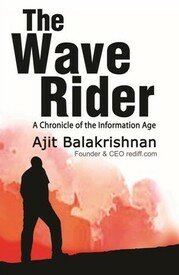Decoding the Information Age

Book: The Wave Rider: A Chronicle of the Information Age
Author: Ajit Balakrishnan
Publisher: Pan Macmillan
Pages: 162
Price: Rs 599
Much of us take the internet boom, or the dot-com era for granted. The what, when, why, where and how of internet evolution in India remain ignored as unconnected dots. So when you browse through books in a virtual bookstore and happen to see a book promising to explain this very phenomenon, you are bound to get fascinated. And who better to explain the phenomenon than Ajit Balakrishnan, Founder, Chairman and CEO of Rediff.com.
Google and Yahoo! may have taken over as the most preferred e-mail service providers today, but during the nineties and well into the 2000s, Rediffmail gave most Indians their first e-identities. At a time when the internet was nothing more than distant sci-fi wonder called the Information Highway, Rediff.com gave Indians their first e-mail experience, a chat room (soon followed by Hotmail and Yahoo!) and an introduction to the term “news portal”.
 Pic Courtesy: LiveMint
Pic Courtesy: LiveMint
At 162 pages, Ajit Balakrishnan’s recently launched book, The Wave Rider, is a quick read. Many may argue that 162 pages to explain the evolution of a phenomenon, which took India by storm, is not enough, but the fact of the matter is, Balakrishnan knows what he is doing and he understands his audience.
When questioned about the length of the book, Balakrishnan told the Financial Express, “It was a conscious decision to make it short and simple for it to be of as much use to a general reader as it might be to an Internet practitioner, a business school student, and the like. And you need to have some mercy on the readers. In today’s time and age when attention spans are constantly shrinking, I don’t want to burden my readers with 700 pages of business and technology jargon.”
The book is not a literary genius, neither does it claim to be. What works for Balakrishnan is that he successfully explains a very complex phenomenon without boring his readers. So you will not see a lot of fancy jargons, which is almost a given when dealing with any subject on technology, neither will you see any ‘Gyan’ from a man who is considered as the pioneer of the internet revolution in India. As a reader, I felt as if Balakrishnan was sitting in his first six by eight office (the setting of the second scene in the book) and narrating his life-experiences in a series of anecdotes over a cup of coffee.
The narrative is non-linear and personal, at times, cold and calculative, at others deep, philosophical and passionate. So while taking you on Rediff.com’s journey to New York’s NASDAQ, Balakrishnan also recounts his first tryst with a computer, then called “Unit Record System”, in IIM-Calcutta in 1970; the history of the “domestication” of computers as we know it today; the financial crashes of 2000 and 2008; the New York September 11 terror attacks and the class action lawsuits filed against him in lower Manhattan.
Balakrishnan never loses sight of what he is trying to convey - he effortlessly binds all these seemingly unconnected events, from the financial crashes to the terror attacks, with the information age and Rediff.com’s journey. The emotional, if not romantic connection that Balakrishnan shares with the information age is revealed in the concluding chapter of the book; he worries about the “concentration of power” in the information age, while at the same time reflects on his father’s “modernism” in a small south Indian town. He ends on a very emotional note, wondering what his townspeople would inscribe on his tombstone “when the time comes.”
The book works on multiple levels: as a historic reference point, it gives insight into an era where the concept of internet was still alien in India; as a guidebook for entrepreneurs looking to step into unchartered territories; as a chronicle of important technological milestones; and more importantly as a looking-glass into the world of Ajit Balakrishnan as an entrepreneur, and as a man.
Sahim Salim is the Editor of India Tourism Review, our network website covering tourism industry in India






